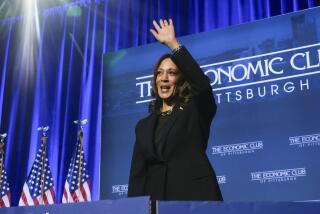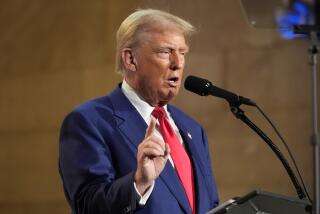Bush Hopes to Double Economy to $10 Trillion : Campaign: President sets goal for gross domestic product in a speech that pulls together past proposals for job training, health care and education.
DETROIT â President Bush, striving to demonstrate a comprehensive plan to pull the nation out of its economic doldrums while hoping to boost his reelection campaign, set a goal Thursday of building a $10-trillion U.S. economy.
If achieved, the target for post-recession growth would nearly double the size of the U.S. economy--as measured by the value of the goods produced in its factories and the services its workers offer--by the early years of the 21st Century. It would mean equaling the rate of growth in gross domestic product from 1980-89, including inflation.
In a lengthy speech that focused on the failures of the past and the challenges of the future--and little on the most immediate and pressing problems facing American workers--the President offered no new plans or short-term solutions to ease recession-induced fears over job security.
Instead, the speech pulled together the swath of programs Bush has proposed in the past to deal with such pressing problems as job training, health care and education. He related them to their potential impact on the U.S. economy and sought to make a case for the ever-growing links between the U.S. economy and global markets.
The speech to the Economic Club of Detroit, titled âAgenda for American Renewal,â outlined a philosophical approach that calls for cutting taxes, paying for the tax cuts by reducing government spending, and producing a shrunken government, in the process providing incentives to a streamlined business community so that it can reach the $10-trillion goal.
âThatâs the direction I want to go: Tax less. Spend less. Cut the deficit. And redirect our current spending to serve the interests of all Americans,â Bush said.
For the first time, Bush attached a specific figure to the across-the-board tax cut that he says he would seek from Congress if reelected. But the 1-percentage-point figure he cited was offered only as an example of what could be achieved if all the spending cuts for which he has called, valued at roughly $130 billion, were approved by Congress.
âThat is an illustration because it would depend on if you could get the $130 billion,â a senior Administration official said, explaining that Bushâs purpose in using the figure was to demonstrate the sort of break taxpayers would get in return for cuts in government spending.
And in what he called ârightsizingâ government, Bush said he would cut the operating budget of the Executive Office of the President, which includes his immediate staff of assistants and secretaries and hundreds of people working in the Office of Management and Budget and other executive branch agencies, by 33% if Congress--with a staff many times larger--agrees to a similar percentage reduction in its operating budget.
âWith fewer congressional staffs badgering us for endless reports and endless visits to Capitol Hill, I know we can cut costs by that amount,â he said.
âAnd,â he said, âIâll cut the salaries of all federal employees earning more than $75,000 by 5%. Taxpayers have tightened their belts. The better-paid federal workers should do the same.â
Such a cut would trim his own $200,000 salary by $10,000 a year.
Democratic presidential nominee Bill Clinton said the Presidentâs proposals amounted to more of the same programs that have led the nation into economic decline.
âI strongly believe we have to go beyond the failed policies of this Administration, beyond trickle-down economics. We need real incentives to invest in this country, to educate our people, to control health care costs and to compete around the world,â he said by satellite from the governorâs mansion in Little Rock, Ark.
Clinton contended that under Bushâs plan, Americans with incomes of more than $200,000 would get a $14,000 tax cut, whereas those making $20,000 would get about $50.
But despite Clintonâs critique and Bushâs own description of a âgrand canyonâ between himself and Clinton, Bushâs speech and an address Clinton delivered to the same organization on Aug. 21 demonstrated the degree of similarity in their approaches. Clinton based his economic program on âjob-creating investment,â including job training, education reform, and improved health care; and on using money saved from reduced defense spending to invest in new civilian technologies.
The principle difference with Bush, as outlined in that speech, is over the formation of a ânational economic strategy,â which the President labels an âindustrial policyâ that he says would give government too great a role in directing the nationâs businesses.
âOur nation has never been seduced by the mirage that my opponent offers--of a government that accumulates capital by taxing it and borrowing it from the people and then redistributing it according to some industrial policy,â Bush said. âWe know that the clumsy hand of government is no match for the uplifting hand of the marketplace.â
The address included only a few direct attacks on Clinton and dealt instead with Bushâs view of how to achieve a vibrant economic future in which the United States would compete with other global powers.
âI know that times have been very, very difficult for many Americans. The world that we knew as children, no matter your age, will never be the same. America will change--thatâs our destiny; how it will change will soon be decided,â Bush said.
âFor America to be safe and strong, we must meet the defining challenge of the 1990s: to win the economic competition, to win the peace. We must be a military superpower, an economic superpower and an export superpower.â
More than a year ago, the recession and troublesome unemployment rates in the vicinity of 7.8% punctured Bushâs soaring poll ratings in the wake of the Persian Gulf War. And throughout this election year, the economy has been the riveting issue that has fueled the attacks on Bush from within his own party and from Democrats.
Bush has made multiple efforts over the months to present himself as concerned and eager to act on the economy, but his political fortunes did not improve. The new team of White House assistants, under Chief of Staff James A. Baker III, hoped that Thursdayâs speech would be what the senior Administration official called âa conceptual document that seeks to integrate the different proposals we have.â
âPerhaps the point we havenât conveyed effectively is how this fits together,â the official said.
In addition to delivering the 39-minute speech, Bush taped a five-minute encapsulation of the same points to be broadcast on major television networks Thursday evening. And the campaign printed a 29-page expansion of the speech intended for distribution to schools, libraries, political groups and individuals who seek it from the campaign organization.
The President said that in the first year of a second term, he would press Congress for approval of the 13 central elements of his existing program:
Overhauling the nationâs education system; job training; health care reforms; streamlining government; spending cuts; tax cuts; approval of the North American Free Trade Agreement; expansion of trade-negotiating authority to push for free trade agreements with Poland, Hungary, Czechoslovakia, Asian nations and others in the Western Hemisphere; reforms of the legal system; urban programs to cut crime and build inner-city investment; expansion of research and development; campaign contributions reform, and placing limits on congressional terms.
âThe purpose of this speech, frankly, and this agenda is not to be trying to propose magic bullets or try to throw out a set of new ideas 60 days before the election,â the senior Administration official said. âItâs to say: These are some of the things Iâve been working on. Iâve got some of them under way. Thereâs others Iâm just starting. But hereâs how they fit together as a package.â
Bushâs plan was unveiled as the White House struggled to explain the Presidentâs tax statements of a day earlier.
A day after Bush told a New Jersey audience: âI went along with one Democratic tax increase and Iâm not going to do it again--ever, ever,â Press Secretary Marlin Fitzwater insisted that Bush was not repeating his famous broken pledge of 1988: âRead my lips--no new taxes.â
Bush was given a polite, if not overly enthusiastic, reception in Detroit. He spoke for 22 minutes before the audience reacted with applause; and then, it was to show support for his often-stated goal of providing up to $1,000 in tuition payments to give parents a choice of sending their children to public, private or parochial schools.
The speech and the accompanying booklet were organized much like a high school essay, outlining major points and then providing supporting evidence to flesh out the Presidentâs arguments as he reviewed âsix interconnected fronts . . . five profound changes . . . four guiding principles . . . three key features.â
As he sought to explain how the nation could tumble from the boom of the 1980s to the woes of today, Bush cited five developments:
--The cutbacks in the defense industry, prompted by the end of the Cold War.
--Restructuring of U.S. industries, âa revolution as dramatic as the one made earlier this century when Henry Ford led the country from craft-based production to mass manufacturing.â
--Payment of the debts incurred in the 1980s, which have made consumers and companies cautious about spending.
--Failure of an outmoded banking system, âdesigned for the days when tellers wore green eyeshades,â to keep up with the demands of an era when billions of dollars are moved around the world in a flash.
--The emergence of a global economy, the development Bush called âthe most far-reaching.â
More to Read
Get the L.A. Times Politics newsletter
Deeply reported insights into legislation, politics and policy from Sacramento, Washington and beyond. In your inbox three times per week.
You may occasionally receive promotional content from the Los Angeles Times.









